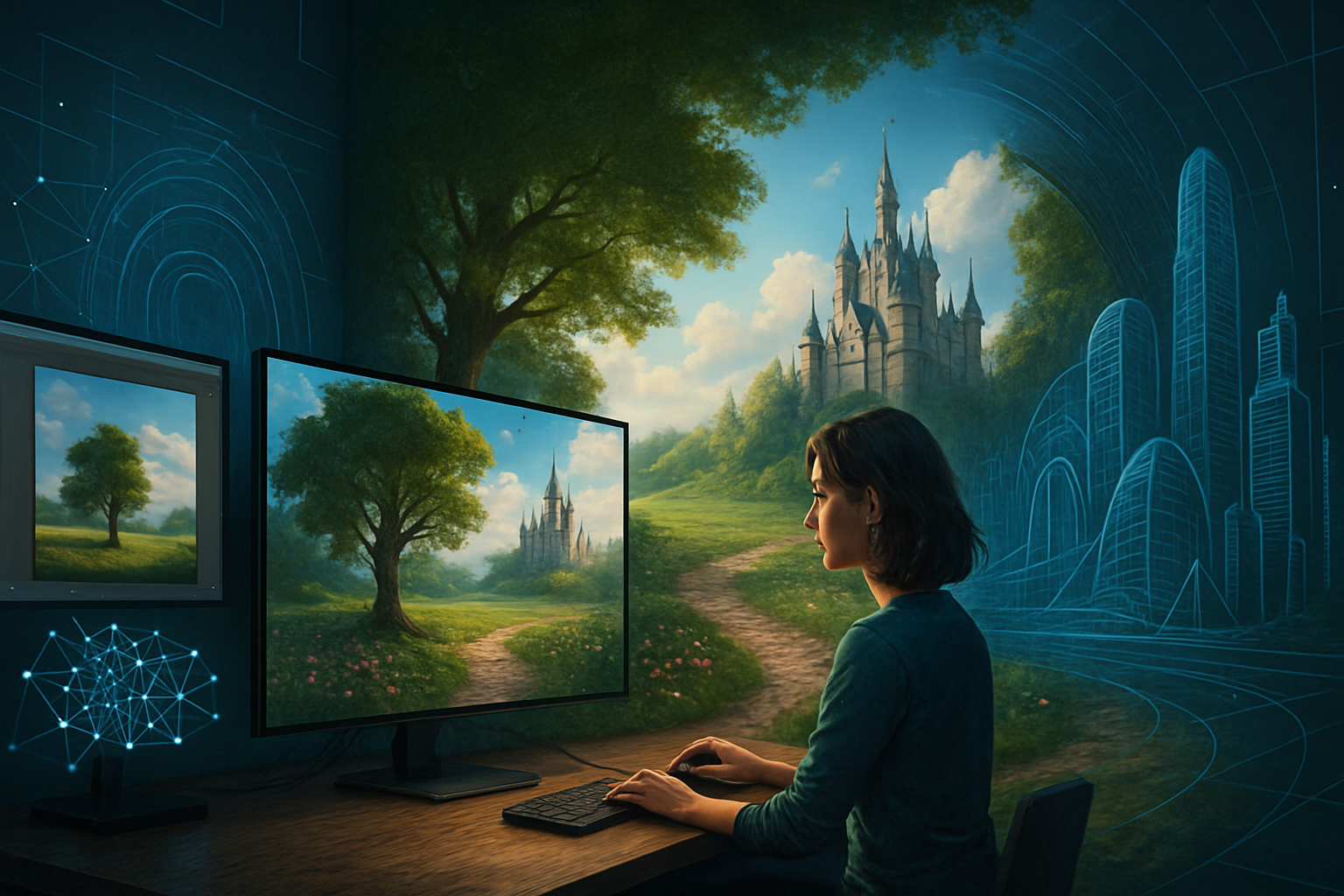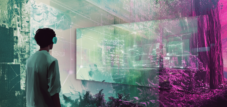
AI-controlled 3D worlds: Revolution of Immersive Technology-This is how dreams and photos become accessible 3D worlds-Image: Xpert.digital
From the text to the dream world: This start-up lets you hike through your own imagination
A walk in the dream painting? This AI makes it possible - and you can test it yourself
The world of artificial intelligence makes a huge leap forward into the three -dimensional future. The Ki start-up World Labs, founded by the renowned Stanford researcher Fei-Fei Li, has developed an exciting technology that generates interactive 3D environments from simple text descriptions or 2D images. This innovation enables users to immerse yourself in fully artificially created 3D worlds using VR glasses such as the Meta Quest 3 or the Apple Vision Pro.
The “Lofi Worlds” application impressively demonstrates the potential of this technology. Users can immerse themselves in a fictional Swiss mountain village in front of majestic alpine backdrop, walk through impressive steampunk cities with artistic watches and pointed towers or walk through fairytale forests full of fluorescent giant mushrooms. These worlds range from photo -realistic representations to fantastic dream landscapes to artistically stylized environments, which even expand famous paintings such as Edward Hopper's “Nighthawks” to expand additional dimensions.
The visionary behind the technology
Fei-Fei Li, often referred to as “Godmother of AI”, is a pioneer of artificial intelligence with exceptional merits about the development of computer vision. It is known for the development of the Imagenet data set, which is considered one of the three pillars of the modern AI revolution. As a sequoia professor at Stanford University and co-founder of the Stanford Institute for Human-Centered AI, she brings a unique expertise into the world of spatial intelligence.
Li is convinced that the next major development step in the AI is in spatial intelligence - the ability to understand spaces and interact with three -dimensional environments. This competence would enable AI systems not to consider the world only as two-dimensional, static images, but to understand as a dynamic, walk-in reality.
Technical basics and innovations
The heart of the World Labs Technology is 3D Gaussian Splatting, an innovative rendering technique that assembles three-dimensional environments from tiny, spatially arranged color particles. This method creates images that resemble an impressionistic work of art, since the individual colors only fake landscapes from the overall perspective.
Lofi Worlds's revolutionary innovation is that these splashes are not static, but can react dynamically. They move gently in the wind, simulate the rustling of leaves or start waving when they are touched as if they were alive. This interactivity is made possible by Spark technology, a 3D renderer for web applications specially developed by World Labs.
Spark uses webgl2 for the rendering of the Gaussian Splats and is compatible with the widespread 3D graphics library Three.js. This combination ensures broad device compatibility and enables the application not only to be used on VR glasses, but also on smartphones and desktop computers.
WebxR: The bridge between web and virtual reality
The accessibility of Lofi Worlds is made possible by webXR technology, an open web API that makes immersive experiences available directly in the browser. WebXR stands for Extended Reality and supports both virtual reality and augmented reality without the need for special app downloads.
This technology revolutionizes the way in which immersive content is provided because it creates a seamless interface between web and VR. Developers can create XR applications that work on a variety of devices, from mobile devices to high-end-VR headsets. The range is maximized while the programming effort is minimized.
Virtual Reality Hardware and Hand Tracking
The Meta Quest 3 and the Apple Vision Pro represent the latest generation of self-sufficient VR glasses that can carry out complex 3D applications without external computers. These devices have integrated hand tracking technology that enables users to interact directly with virtual objects with their hands.
Hand tracking works through cameras and sensors that capture the position, depth, speed and alignment of the hands in real time. This data is analyzed and converted into a virtual representation of the hand movements, which is then integrated into the 3D environment. The technology makes it possible to grab, manipulate or throw objects without needing physical controllers.
Artificial intelligence and spatial intelligence
World Labs pursues the ambitious goal of developing so-called “Large World Models”-AI systems that can understand and generate persistent, walk-in and geometrically correct 3D environments. These models should enable AI to perceive the world and people as spatial and physically experienced.
Spatial intelligence is the ability to imagine spaces and interact with objects - a competence that combines perception with action. For example, when people see a glass on a table, the brain immediately processes its geometry, placement and relationship with other objects. This type of spatial consciousness is crucial that AI can really understand the real world and interact with it.
Challenges and limitations
Despite the impressive progress, the technology still has significant restrictions. Freedom of movement in the 3D worlds is very limited-after a few virtual meters, users reach invisible limits that destroy the illusion of a continuous 3D world. In addition, the resolution is comparatively low and the image is often out of focus.
Anyone who moves too far from the original perspective will discover dark empty spaces in the Gaussian Splats, which affect immersion. These problems are typical of early developmental stages of new technologies and are expected to be remedied with the further development of the algorithms and the available computing power.
🗒️ Xpert.Digital: A pioneer in the field of extended and augmented reality
World Labs: The start-up transforms words into photo-realistic 3D environments
Areas of application and future perspectives
The possible uses for AI-generated 3D worlds are diverse and extensive. In the film industry, complex scenes and environments could be created without elaborate backdrops or computer graphics teams. Architects could present their designs in walk-in 3D models, while game developers could generate new worlds in record time.
In the field of education, completely new opportunities for immersive learning experiences open up. History hours could take place in historically accurate 3D reconstructions, while biology lessons could be carried out in detailed cell structures or ecosystems. Medicine could benefit from the technology by practicing surgical interventions in virtual environments or therapies are carried out in soothing, artificially generated landscapes.
Rendering technology and visual quality
The 3D Gaussian Splitting technology used offers several advantages over conventional polygon models. Instead of using solid geometric structures, the process is based on dynamic point clouds that adapt flexibly to light situations and perspectives. This enables an incredible level of detail in which the finest surface structures are reproduced true to the original.
The impressionist appearance caused by the Splitting technique is reminiscent of the painting style of the French Impressionists of the 19th century. As with a painting by Claude Monet, the individual color points only form from a distance to a coherent picture. This property gives the artificially generated worlds a special aesthetic quality.
Market position and investments
Despite the early stage of development, World Labs has already collected $ 230 million risk capital. Investors include renowned risk capital companies such as Andreessen Horowitz and New Enterprise Associates as well as technology groups such as AMD, Intel and Nvidia. These considerable investments underline the trust of the industry in the potential of spatial AI technology.
The 20-member company is working on making the technology over the market by 2025 and fundamentally revolutionizing the creation of 3D content. The vision is to develop a generative AI that creates complete, accessible 3D environments based on text descriptions or individual images.
Social and cultural effects
The development of AI-generated 3D worlds could have far-reaching social effects. On the one hand, it democratizes the creation of high-quality 3D content, since no special knowledge in 3D modeling or animation is required. On the other hand, she raises questions about authenticity and the value of human creativity.
In the entertainment industry, new forms of storytelling could develop, in which spectators are not only passive consumers, but also become active participants in the stories. Immersive experiences could fundamentally change the traditional understanding of the media and entertainment.
Technical challenges and solutions
The development of Large World Models represents significant technical challenges. The processing of millions of tokens from video and language data requires innovative approaches to storage management and calculation. World Labs uses advanced techniques such as ring adaptation to train on long sequences and gradually increase the context size from 4,000 to one million tokens.
The quality of the generated worlds depends heavily on the training quality of the underlying AI models. The more varied and extensive the training data, the more realistic and detailed the 3D environments generated. The challenge is to collect and process sufficiently high quality 3D data.
Comparison with traditional 3D creation methods
Traditional 3D modeling requires specialized software such as Blender or Maya as well as years of experience in 3D design. The process is time -consuming and requires detailed knowledge of geometry, texture and lighting. AI-generated 3D worlds, on the other hand, can be created in minutes or hours based on simple text descriptions or reference images.
This increase in efficiency could revolutionize the 3D industry, similar to text generators influenced the writing industry. Professional 3D artists could shift their role from manual creation to the curation and refinement of AI-generated content.
Outlook and future development
The future of the AI-generated 3D worlds promises exciting developments. With the further development of the technology, the quality, detailed and interactivity of the generated environments are continuously improved. Integration with other AI systems such as voice models and robot technology could open up completely new fields of application.
In medicine, AI-controlled smart sensors could improve patient care by monitoring the hygiene of clinic staff or logging in the use of surgical instruments. A future in which autonomous robots transport medical supplies, leads augmented reality surgeons and patients with severe paralysis control robot arms with their thoughts, is within reach.
The development of World Labs and similar companies shows that we are at the beginning of a new era of spatial intelligence. Computers and robots are equipped with the ability to conclude and interact with the three -dimensional world. These digital systems could become trustworthy partners in our endeavor to understand and improve the world.
World Labs technology is more than just a technical innovation - it is a window to a future in which the boundaries between the physical and the digital world blur. With every progress in spatial intelligence, we get closer to a world in which AI not only processes information, but also understands rooms, creates and interacted with them.
We are there for you - advice - planning - implementation - project management
☑️ SME support in strategy, consulting, planning and implementation
☑️ Creation or realignment of the digital strategy and digitalization
☑️ Expansion and optimization of international sales processes
☑️ Global & Digital B2B trading platforms
☑️ Pioneer Business Development
I would be happy to serve as your personal advisor.
You can contact me by filling out the contact form below or simply call me on +49 89 89 674 804 (Munich) .
I'm looking forward to our joint project.
Xpert.Digital - Konrad Wolfenstein
Xpert.Digital is a hub for industry with a focus on digitalization, mechanical engineering, logistics/intralogistics and photovoltaics.
With our 360° business development solution, we support well-known companies from new business to after sales.
Market intelligence, smarketing, marketing automation, content development, PR, mail campaigns, personalized social media and lead nurturing are part of our digital tools.
You can find out more at: www.xpert.digital - www.xpert.solar - www.xpert.plus

